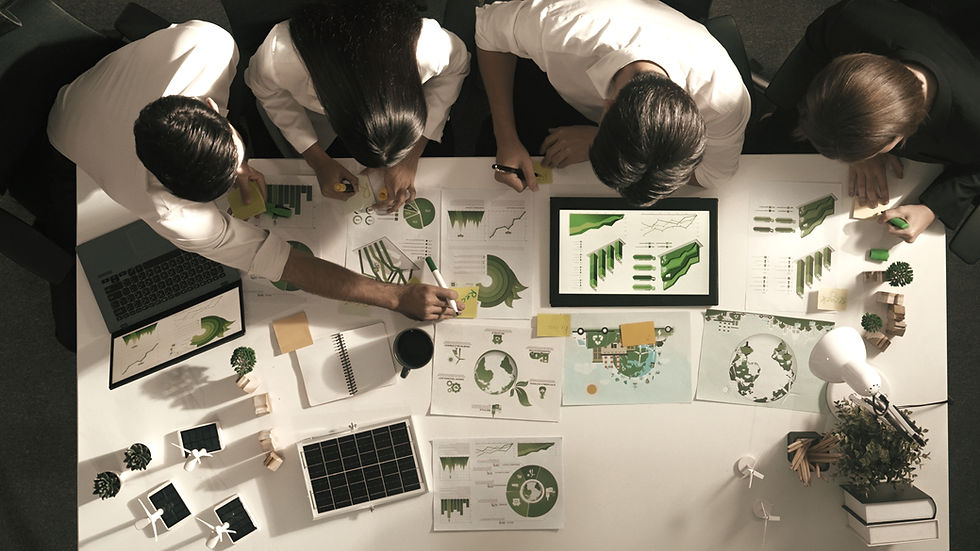The Future of Energy: Why Solar and Wind Power Outperform Nuclear
- Frank Hummel

- Oct 22, 2024
- 5 min read

If you are looking for a reliable, cost-effective and sustainable energy source for your business, organization, community or city, now is the time to look into the possibilities of solar and wind energy. These technologies not only offer significant cost advantages, but also enable rapid implementation - exactly what you need in a changing energy landscape to be future-proof. With Frank Hummel Consulting, you can discuss the first steps towards implementing a climate-neutral and economically efficient energy solution. Take the opportunity and benefit from our expertise to shape your energy future together.
The growing benefits of solar and wind power
1. Construction and investment costs
The costs of installing solar and wind power plants have fallen rapidly in recent years. According to international studies, the construction costs of photovoltaic systems have fallen by more than 80% since 2010. Wind energy has also experienced significant cost reductions. This development makes solar and wind energy the cheapest energy sources available today.
What is particularly noteworthy is that a large part of the investment in these technologies comes from private investors - companies, municipalities and private individuals. This shows that solar and wind power are not only dependent on government subsidies, but that there is widespread interest in investing in these sustainable energies. Decentralized energy production is a key advantage: energy is generated and distributed locally, which reduces dependence on large central power plants and increases the security of the electricity supply in times of crisis.
In contrast, the construction costs for nuclear power plants are constantly rising. Modern reactors are technically complex and the safety requirements are high, which makes construction significantly more expensive. In addition, budget overruns and delays are common. Large-scale projects such as the construction of nuclear power plants in Finland or Great Britain have shown that costs can get out of control. In comparison, wind and solar plants are not only cheaper, but also ready for use much more quickly.
2. Construction time and flexibility
The construction time of a nuclear power plant can be up to 10 or even 20 years, if you take into account permits, planning processes and the actual construction. In a world that urgently needs to reduce CO2 emissions, these are lost years. Wind and
Solar parks, on the other hand, can be built and connected to the grid within a few years or even months.
This flexibility is an enormous advantage: while we wait for a nuclear power plant to be completed, numerous solar and wind projects could already be implemented, which would immediately contribute to reducing greenhouse gases.
Renewable energies: flexible, modern and cost-effective
A common argument against solar and wind energy is their dependence on weather conditions. It is true that the sun does not always shine and the wind does not always blow. But with modern storage technologies and intelligent power grids (smart grids), these fluctuations can already be balanced out today.
Battery storage systems make it possible to store excess energy and feed it back into the grid when needed. There are also approaches to using electric vehicles as decentralized storage to further improve grid stability. These technologies are developing rapidly, making the use of renewable energies ever more efficient and reliable.
Cost advantages through decentralized energy production
Another key benefit that is often overlooked is the fact that locally generated energy, which is consumed directly where it is produced, also reduces the cost of expanding electricity networks. This is because the less electricity has to be transported over long distances, the less need there is to strengthen transmission networks or build new lines. This not only saves costs, but also time and reduces administrative burdens.
Nuclear power plants, on the other hand, often require extensive grid expansion because they supply large amounts of electricity to a few central points, from where it must be transported over long distances to consumers. Renewable energies, on the other hand, can be installed decentrally in many regions, which reduces the need for major grid expansion while increasing security of supply.
Nuclear power plants, on the other hand, often require extensive grid expansion because they supply large amounts of electricity to a few central points, from where it must be transported over long distances to consumers. Renewable energies, on the other hand, can be installed decentrally in many regions, which reduces the need for major grid expansion while increasing security of supply.
Nuclear Power: Long-Term Risks and Challenges
Nuclear power may seem like a solution for stable energy at first glance, but the risks and long-term problems are serious. One of the biggest unsolved problems is radioactive waste, which must be safely stored for thousands of years. There is still no definitive solution worldwide for the final disposal of this dangerous waste, which entails immense costs and safety risks.
There is also the risk of accidents. Despite modern safety precautions, there is always the possibility that technical malfunctions or natural disasters will lead to devastating accidents such as those in Chernobyl or Fukushima. These events have shown that the effects of nuclear accidents are unpredictable and extremely costly - both financially and in terms of people and the environment.
Solar and wind power: Sustainable energy without risk
In contrast, solar and wind power plants do not generate hazardous waste and do not pose a risk to the population. They produce neither emissions nor pollutants during their operation. In the long term, they are not only more cost-effective, but also more sustainable and safer.
Renewable energies also have an advantage when it comes to maintenance costs: while nuclear power plants require complex and expensive maintenance, the operating costs for solar and wind power plants are comparatively low. The sun shines for free, the wind blows for free - and for many years without any additional raw material costs.
Conclusion: The future is renewable, let’s tackle it:

The world is facing the challenge of combating climate change while ensuring a stable energy supply. Solar and wind power combined with storage systems and smart grids offer a sustainable, safe and economical solution that is far superior to nuclear power. Decentralized generation promotes regional value creation, creates jobs, reduces investments in grid expansion and at the same time increases security of supply.
In the long term, nuclear power produces hazardous waste and entails enormous costs and risks. Renewable energies, on the other hand, offer a future-proof alternative: fast, cost-effective, decentralized and environmentally friendly - for a world without nuclear waste and fossil dependencies.
Take advantage of this opportunity and let us work together to create a climate-friendly and economically viable energy future for your company. Arrange a non-binding meeting with Frank Hummel Consulting to develop tailor-made solutions for your challenges.


